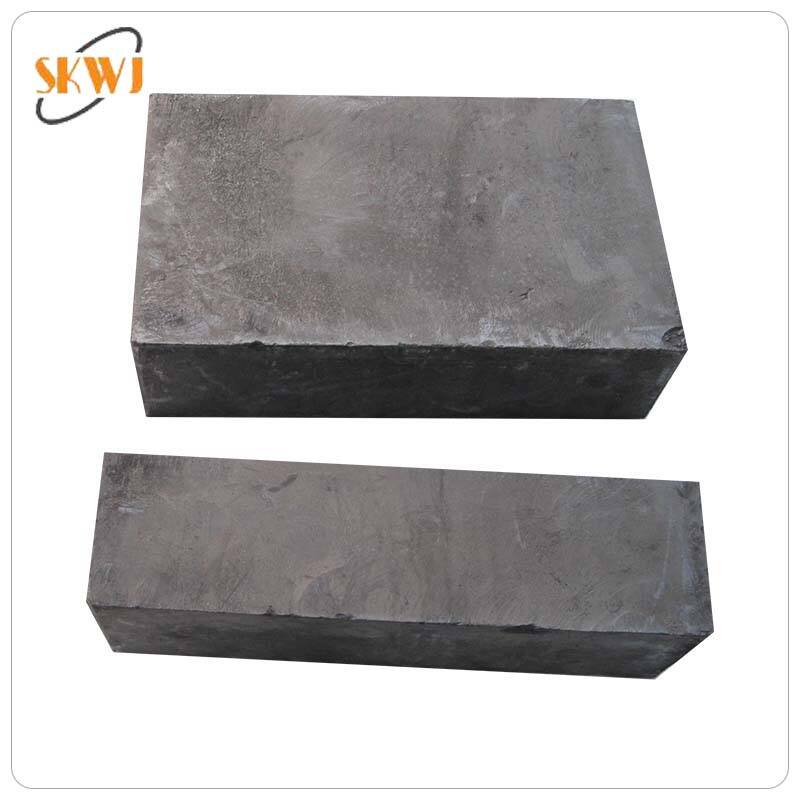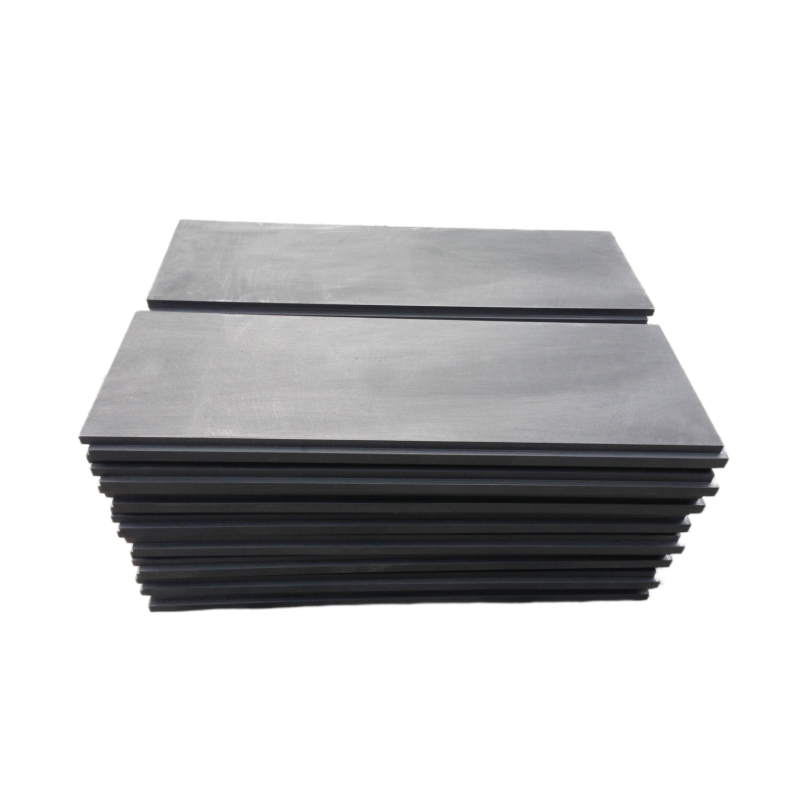Αξιολόγηση Επιλογών Υλικών για Βιομηχανική Απόδοση και Εξοικονόμηση Κόστους
Στη βιομηχανική μηχανική, η επιλογή υλικών επηρεάζει άμεσα την αποδοτικότητα παραγωγής, την ασφάλεια λειτουργίας και τα μακροπρόθεσμα έξοδα. Είτε για κοπή, θερμική μόνωση, ηλεκτρική αγωγιμότητα ή δομικά εξαρτήματα, η συζήτηση μεταξύ μπλοκ Γραφίτη και οι μεταλλικές εναλλακτικές συνεχίζουν να αποσπούν προσοχή. Τα μπλοκ γραφίτη έχουν ευρέως υιοθετηθεί λόγω της θερμικής τους σταθερότητας, της ελαφριάς τους φύσης και της χημικής τους αντοχής, ενώ οι μεταλλικές εναλλακτικές, όπως ο χάλυβας, το αλουμίνιο και ο χαλκός, παραμένουν δημοφιλείς για τη μηχανική τους αντοχή και την οικειότητά τους. Καθώς οι βιομηχανίες επιδιώκουν οικονομικά αποδοτικές, υψηλής απόδοσης και βιώσιμες λύσεις, η κατανόηση των οικονομικών και λειτουργικών συμβιβασμών μεταξύ των μπλοκ γραφίτη και των μεταλλικών εναλλακτικών γίνεται απαραίτητη.
Χαρακτηριστικά Υλικών και Η Επίδρασή Τους Στην Απόδοση
Θερμική διαγωγεία και αντοχή στο θάρρος
Τα μπλοκ γραφίτη είναι γνωστά για την υψηλή τους θερμική αγωγιμότητα και τη δυνατότητα διατήρησης δομικής σταθερότητας υπό ακραίες θερμοκρασίες. Αυτό τα καθιστά ιδιαίτερα αποτελεσματικά σε εφαρμογές υψηλής θερμοκρασίας, όπως καμινάκια, καλούπια χύτευσης και εναλλάκτες θερμότητας. Σε αντίθεση με τις περισσότερες μεταλλικές εναλλακτικές, οι οποίες μπορεί να παραμορφωθούν ή να οξειδωθούν σε υψηλές θερμοκρασίες, ο γραφίτης παραμένει διαστασιακά σταθερός και δεν τήκεται. Για παράδειγμα, τα μπλοκ γραφίτη μπορούν να αντέχουν σε θερμοκρασίες πάνω από 3000°C σε μη οξειδωτικό περιβάλλον, ενώ συνηθισμένα μέταλλα, όπως το αλουμίνιο ή το ανοξείδωτο ατσάλι, έχουν πολύ χαμηλότερα θερμικά όρια. Αυτά τα χαρακτηριστικά μειώνουν τις απώλειες ενέργειας και ενισχύουν την ασφάλεια σε βιομηχανικές διαδικασίες που περιλαμβάνουν έντονη θερμότητα.
Αντοχή στη διάβρωση και χημική συμβατότητα
Ένας ακόμη κρίσιμος τομέας στον οποίο τα γραφιτένια μπλοκ υπερτερούν σε σχέση με πολλές μεταλλικές εναλλακτικές είναι η χημική αντοχή. Το γραφίτης είναι αδρανές ως προς τις περισσότερες οξέα και αλκαλικές ουσίες, γεγονός που το καθιστά εξαιρετικά κατάλληλο για εφαρμογές στον χημικό και πετροχημικό τομέα. Οι μεταλλικές εναλλακτικές, παρότι είναι ανθεκτικές ως προς τη μηχανική τους αντοχή, είναι ευαίσθητες στη διάβρωση και απαιτούν ακριβά επικαλύμματα ή επεξεργασίες ώστε να επιβιώσουν σε περιβάλλοντα με χημική δραστικότητα. Σε εργασίες όπου το κόστος συντήρησης και οι χρόνοι αδράνειας του συστήματος πρέπει να ελαχιστοποιηθούν, η αντοχή των γραφιτένιων μπλοκ παρέχει σημαντικό λειτουργικό πλεονέκτημα, το οποίο δικαιολογεί το αρχικό τους κόστος.

Κόστος Παραγωγής και Κατεργασιμότητα
Κόστος Πρώτης Ύλης και Επεξεργασίας
Όσον αφορά τις τιμές των πρώτων υλών, τα μπλοκ γραφίτη και οι μεταλλικές εναλλακτικές παρουσιάζουν σημαντικές διαφορές. Τα μέταλλα, όπως το χάλυβας, είναι συνήθως πιο προσιτά ανά μονάδα πρώτης ύλης. Ωστόσο, το κόστος επεξεργασίας των μπλοκ γραφίτη τείνει να είναι χαμηλότερο λόγω της ευκολίας τους στην κατεργασία. Ο γραφίτης είναι πιο μαλακός και ομοιογενής, κάτι που του επιτρέπει να διαμορφώνεται και να προσαρμόζεται με τυποποιημένα εργαλεία, μειώνοντας τόσο τον χρόνο παράδοσης όσο και τα εργατικά έξοδα. Αντιθέτως, η κατεργασία μεταλλικών εναλλακτικών απαιτεί συχνά εξειδικευμένον εξοπλισμό και πιο ανθεκτικά κοπτικά εργαλεία, αυξάνοντας το συνολικό χρόνο και κόστος παραγωγής. Επομένως, αν και οι μεταλλικές εναλλακτικές μπορεί να φαίνονται πιο οικονομικές στο επίπεδο της πρώτης ύλης, τα μπλοκ γραφίτη προσφέρουν συχνά χαμηλότερο συνολικό κόστος κυρίως όταν λαμβάνονται υπόψη τα έξοδα εργασίας και η φθορά των εργαλείων.
Προσαρμογή και Ευελιξία Σχεδίασης
Τα μπλοκ γραφίτη προσφέρουν εξαιρετική ευελιξία σχεδίασης λόγω της κατεργασιμότητάς τους. Είτε για τη δημιουργία ηλεκτροδίων με πολύπλοκες γεωμετρίες είτε για τη διαμόρφωση εξαρτημάτων για συστήματα μόνωσης, ο γραφίτης μπορεί να διαμορφωθεί με ακρίβεια ώστε να καλύπτει τις απαιτήσεις της εφαρμογής. Οι μεταλλικές εναλλακτικές λύσεις είναι περιορισμένες ως προς αυτό, ειδικά όταν απαιτούνται πολύπλοκα σχήματα ή σχεδιασμοί με λεπτά τοιχώματα. Η ευελιξία των μπλοκ γραφίτη υποστηρίζει επίσης την ταχεία πρωτοτυποποίηση και τον επαναληπτικό σχεδιασμό, καθιστώντας ευκολότερη για τις επιχειρήσεις την πιο γρήγορη εισαγωγή προϊόντων στην αγορά και μειώνοντας τα έξοδα έρευνας και ανάπτυξης. Αυτό το πλεονέκτημα σε προσαρμογή μπορεί να αποτελεί καθοριστικό παράγοντα σε κλάδους που δίνουν προτεραιότητα στην ακρίβεια και την ευελιξία.
Διαρκεία Λειτουργίας και Θέματα Συντήρησης
Αντοχή σε Φθορά και Αντοχή στον Κύκλο Ζωής
Τα μπλοκ γραφίτη παρουσιάζουν εξαιρετική αντοχή στη φθορά, ιδιαίτερα σε περιβάλλοντα που περιλαμβάνουν υψηλές θερμοκρασίες ή συνεχή χημική έκθεση. Με την πάροδο του χρόνου, η αντοχή αυτή μεταφράζεται σε παρατεταμένη διάρκεια ζωής του εξοπλισμού και σε λιγότερους κύκλους αντικατάστασης. Ενώ οι μεταλλικές εναλλακτικές μπορεί να ξεπερνούν στην εφελκυστική αντοχή, συχνά είναι πιο ευάλωτες στη φθορά, τη διάβρωση ή τη θερμική κόπωση υπό απαιτητικές συνθήκες. Η τακτική αντικατάσταση φθαρμένων μεταλλικών εξαρτημάτων δεν προκαλεί μόνο δαπάνες σε υλικά, αλλά οδηγεί και σε καθυστερήσεις παραγωγής και συντήρησης. Έτσι, η διάρκεια ζωής των μπλοκ γραφίτη παρέχει οικονομικό πλεονέκτημα σε εφαρμογές με υψηλή χρήση ή υψηλό κίνδυνο.
Κόστος συντήρησης και χρόνος αδράνειας
Ένα από τα κρυφά αλλά σημαντικά κόστη στην επιλογή βιομηχανικών υλικών είναι η απρογράμματη συντήρηση και η διακοπή της παραγωγής. Τα μπλοκ γραφίτη ελαχιστοποιούν τέτοιες διακοπές αφού απαιτούν λιγότερο συχνή συντήρηση. Η αντοχή τους στη διάβρωση και η θερμική τους σταθερότητα μειώνουν την πιθανότητα ξαφνικής βλάβης. Αντίθετα, τα μεταλλικά υλικά μπορεί να διαβρωθούν ή να στρεβλωθούν υπό πίεση, με αποτέλεσμα απρόβλεπτες διακοπές λειτουργίας. Αυτές οι διαταραχές επηρεάζουν την παραγωγικότητα και συχνά έχουν ως αποτέλεσμα ακριβές επείγουσες επισκευές. Οι επιχειρήσεις που δίνουν προτεραιότητα στη διαθεσιμότητα και την αξιοπιστία μπορούν να επιτύχουν εξοικονόμηση μακροπρόθεσμα χρησιμοποιώντας μπλοκ γραφίτη αντί των παραδοσιακών μεταλλικών εξαρτημάτων.
Ειδικές Εφαρμογές ανά Κλάδο και Οικονομικές Επιπτώσεις
Χρήση σε Χημικές και Πετροχημικές Εγκαταστάσεις
Οι χημικές εγκαταστάσεις απαιτούν υλικά που μπορούν να αντέξουν σε επιθετικές αντιδράσεις, υψηλές πιέσεις και θερμικές καταπονήσεις. Τα μπλοκ γραφίτη χρησιμοποιούνται ευρέως σε εναλλάκτες θερμότητας, επενδυτικά υλικά και εξαρτήματα αντλιών λόγω της αντοχής τους στην οξειδωτική διάβρωση και της σταθερής θερμικής τους απόδοσης. Αν και υπάρχουν μεταλλικές εναλλακτικές, όπως ο τιτάνιο ή το Hastelloy, που παρέχουν χημική αντοχή, συνδέονται με υψηλό κόστος υλικών και συντήρησης. Ο γραφίτης παρέχει πιο οικονομική ισορροπία απόδοσης και οικονομίας σε αυτές τις περιπτώσεις, ιδιαίτερα όταν εφαρμόζεται σε μεγάλες εγκαταστάσεις.
Ρόλος στη χυτευτική μετάλλων και συστήματα καμινιών
Στις χυτηρικές και τις εγκαταστάσεις καμινιών, οι γραφιτένιοι τούβλοι προτιμώνται για επένδυση, κατασκευή καλουπιών και παραγωγή τηγανιών. Η αντοχή τους στα τήγματα μετάλλων, στη θερμική κυκλοφορία και στη χημική επίθεση εξασφαλίζει ότι διατηρούν τη μορφή και τη λειτουργία τους για περισσότερο χρόνο σε σχέση με πολλές εναλλακτικές λύσεις από μέταλλο. Μέταλλα όπως το ανοξείδωτο ατσάλι μπορεί να υποβαθμιστούν πιο γρήγορα και να απαιτούν συχνή αντικατάσταση. Επιπλέον, η μη υγροποιητική φύση των γραφιτένιων τούβλων από τα τήγματα μετάλλων μειώνει τον χρόνο καθαρισμού και την απώλεια υλικού. Αυτό αυξάνει όχι μόνο τη διαδικαστική αποτελεσματικότητα, αλλά μειώνει και το συνολικό κόστος ανά κύκλο σε σχέση με τα μεταλλικά ανταλλακτικά.
Περιβαλλοντική Επίπτωση και Βιωσιμότητα
Ενεργειακή Απόδοση και Αξιοποίηση Πόρων
Τα μπλοκ γραφίτη υποστηρίζουν βιώσιμες επιχειρήσεις μειώνοντας την κατανάλωση ενέργειας. Οι υψηλές θερμικές τους ιδιότητες αγωγιμότητας και μόνωσης επιτρέπουν ταχύτερους κύκλους θέρμανσης και ψύξης, γεγονός που μεταφράζεται σε χαμηλότερους λογαριασμούς ενέργειας. Σε σύγκριση με μεταλλικές εναλλακτικές που μπορεί να απαιτούν παρατεταμένους χρόνους θέρμανσης ή επιπλέον στρώματα μόνωσης, ο γραφίτης είναι εξ ορισμού πιο ενεργειακά αποδοτικός. Επιπλέον, ο γραφίτης είναι διαθέσιμος τόσο από φυσικές όσο και από συνθετικές πηγές, οι οποίες μπορούν να διαχειριστούν με βιώσιμο τρόπο. Αντιθέτως, η εξόρυξη και επεξεργασία μετάλλων όπως το νικέλιο ή ο τιτάνιος είναι εντατική σε πόρους και περιβαλλοντικά καταστροφική.
Ανακυκλωσιμότητα και μείωση αποβλήτων
Η βιωσιμότητα περιλαμβάνει επίσης την επίδραση του υλικού στο τέλος του κύκλου ζωής του. Τα μπλοκ γραφίτη είναι ανακυκλώσιμα και μπορούν συχνά να ξανατρυπηθούν ή να χρησιμοποιηθούν για άλλο σκοπό, επεκτείνοντας έτσι τη χρήσιμη διάρκεια ζωής τους. Τα απόβλητα από την κατεργασία γραφίτη είναι λιγότερο επικίνδυνα και μπορούν να διαχειριστούν πιο εύκολα σε σχέση με τα μεταλλικά ρούπια, ειδικά εκείνα που περιλαμβάνουν τοξικές επικαλύψεις ή υπολείμματα κραμάτων. Αν και κάποιες μεταλλικές εναλλακτικές είναι ανακυκλώσιμες, η διαδικασία είναι πιο ενεργοβόρα και μπορεί να περιλαμβάνει τοξικά παραπροϊόντα. Οι βιομηχανίες που στοχεύουν στην επίτευξη ουδετερότητας σε άνθρακα ή στη λήψη πιστοποιήσεων για πράσινες πρακτικές μπορούν να επωφεληθούν από την ενσωμάτωση μπλοκ γραφίτη στις επιχειρησιακές τους διαδικασίες.
Μελλοντικές Τάσεις και Καινοτομία στα Υλικά
Τεχνολογικές Εξελίξεις στον Γραφίτη
Οι συνεχείς καινοτομίες ενισχύουν τις δομικές ιδιότητες και το εύρος εφαρμογών των γραφιτένιων μπλοκ. Προηγμένες μέθοδοι κατασκευής, όπως η ισοστατική διαμόρφωση και η επεξεργασία υψηλής καθαρότητας, έχουν παράγει ποιότητες γραφίτη που υπερβαίνουν τις παραδοσιακές προσδοκίες. Αυτές οι βελτιώσεις καθιστούν τα γραφιτένια μπλοκ πιο ανταγωνιστικά σε σχέση με τα μεταλλικά εναλλακτικά, ακόμη και ως προς τη μηχανική αντοχή. Καθώς όλο και περισσότερες βιομηχανίες εξερευνούν τα πλεονεκτήματα της διαχείρισης θερμότητας και της βιωσιμότητας των υλικών, ο γραφίτης αναμένεται να γίνει ακόμη πιο διαδεδομένος σε τομείς που μέχρι σήμερα κυριαρχούνταν από τα μέταλλα.
Αλλαγές στην Αγορά και Πορεία του Κόστους
Οι τάσεις της αγοράς υποδεικνύουν αυξανόμενη προτίμηση για υλικά που εξισορροπούν την απόδοση, το κόστος και το περιβαλλοντικό αποτύπωμα. Ενώ το κόστος των πρώτων υλών για μπλοκ γραφίτη μπορεί να μεταβάλλεται, η συνολική οικονομική αξία συνεχίζει να αυξάνεται λόγω των μειωμένων αναγκών συντήρησης, της δυνατότητας προσαρμογής και της επιχειρησιακής αποδοτικότητας. Τα μεταλλικά εναλλακτικά παραμένουν εφικτά, αλλά μπορεί να αντιμετωπίσουν αυξήσεις στο κόστος που οφείλονται στη ζήτηση, στη γεωπολιτική αναταραχή ή σε αυστηρότερους περιβαλλοντικούς κανονισμούς. Καθώς οι παγκόσμιες βιομηχανίες εξελίσσονται, τα μπλοκ γραφίτη βρίσκονται σε θέση να προσφέρουν μια επενδυτικά ασφαλή εναλλακτική λύση στα παραδοσιακά μέταλλα.
Συχνές Ερωτήσεις
Πώς συγκρίνονται τα μπλοκ γραφίτη με τα μεταλλικά εναλλακτικά ως προς το κόστος;
Ενώ τα μεταλλικά εναλλακτικά μπορεί να έχουν χαμηλότερο αρχικό κόστος υλικού, τα μπλοκ γραφίτη συχνά έχουν ως αποτέλεσμα χαμηλότερο συνολικό κόστος λόγω της ευκολίας κατεργασίας, της ανθεκτικότητας και των ελάχιστων απαιτήσεων συντήρησης. Με την πάροδο του χρόνου, τα μπλοκ γραφίτη παρέχουν καλύτερη οικονομική αποδοτικότητα σε απαιτητικές εφαρμογές.
Είναι τα μπλοκ γραφίτη πιο βιώσιμα από τα μεταλλικά εναλλακτικά;
Ναι, τα μπλοκ γραφίτη έχουν γενικά μικρότερο περιβαλλοντικό αντίκτυπο. Απαιτούν λιγότερη ενέργεια για την επεξεργασία τους, παρέχουν υψηλή ανακύκλωση και υποστηρίζουν ενεργειακά αποδοτικές διεργασίες. Οι μεταλλικές εναλλακτικές συχνά περιλαμβάνουν πιο εντατικές διαδικασίες εξόρυξης, καθαρισμού και ανακύκλωσης.
Σε ποιες βιομηχανίες χρησιμοποιούνται συνήθως μπλοκ γραφίτη αντί για μέταλλα;
Τα μπλοκ γραφίτη προτιμώνται σε βιομηχανίες όπως η χημική βιομηχανία, η μεταλλουργία, η ηλεκτρονική και η παραγωγή ενέργειας, λόγω της υψηλής θερμικής αντοχής τους, της χημικής αδράνειας και της επεξεργασίας τους. Αυτοί οι τομείς επωφελούνται από τη μακροχρόνια αντοχή και τα πλεονεκτήματα απόδοσης του γραφίτη.
Μπορούν τα μπλοκ γραφίτη να αντικαταστήσουν πλήρως τις μεταλλικές εναλλακτικές σε όλες τις εφαρμογές;
Όχι πάντα. Τα μπλοκ γραφίτη είναι ιδανικά για υψηλές θερμοκρασίες και διαβρωτικά περιβάλλοντα, αλλά μπορεί να μην ανταγωνίζονται την εφελκυστική ή την κρουστική αντοχή ορισμένων μετάλλων. Η επιλογή εξαρτάται από συγκεκριμένες λειτουργικές απαιτήσεις, συμπεριλαμβανομένων των μηχανικών φορτίων, της θερμικής τάσης και της χημικής έκθεσης.
Πίνακας Περιεχομένων
- Αξιολόγηση Επιλογών Υλικών για Βιομηχανική Απόδοση και Εξοικονόμηση Κόστους
- Χαρακτηριστικά Υλικών και Η Επίδρασή Τους Στην Απόδοση
- Κόστος Παραγωγής και Κατεργασιμότητα
- Διαρκεία Λειτουργίας και Θέματα Συντήρησης
- Ειδικές Εφαρμογές ανά Κλάδο και Οικονομικές Επιπτώσεις
- Περιβαλλοντική Επίπτωση και Βιωσιμότητα
- Μελλοντικές Τάσεις και Καινοτομία στα Υλικά
-
Συχνές Ερωτήσεις
- Πώς συγκρίνονται τα μπλοκ γραφίτη με τα μεταλλικά εναλλακτικά ως προς το κόστος;
- Είναι τα μπλοκ γραφίτη πιο βιώσιμα από τα μεταλλικά εναλλακτικά;
- Σε ποιες βιομηχανίες χρησιμοποιούνται συνήθως μπλοκ γραφίτη αντί για μέταλλα;
- Μπορούν τα μπλοκ γραφίτη να αντικαταστήσουν πλήρως τις μεταλλικές εναλλακτικές σε όλες τις εφαρμογές;






